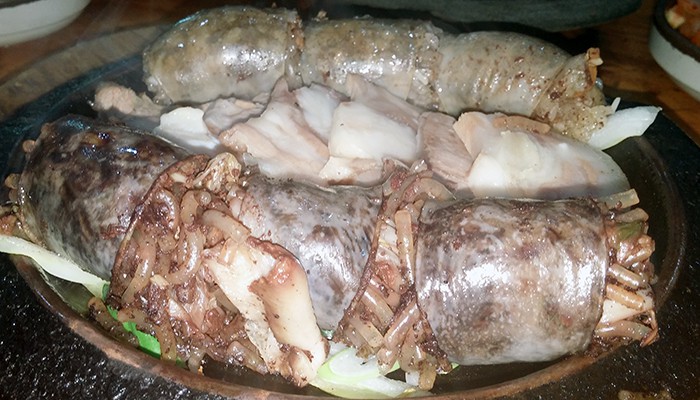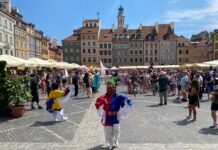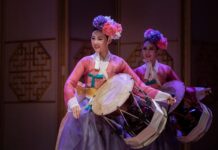At its core, Korean cuisine is based on the geography of the Korean Peninsula itself. The land creates the cuisine; or, to put it another way, the cuisine evolves from the Earth. Surrounded by water on three sides, and mountainous from top to bottom, the Korean Peninsula is home to a wide, wide range of meats and seafoods, of grains and vegetables.
The vast variations found within and among Korean cuisines are generally delineated by territory and home province. The Korean Peninsula stretches from 43 degrees north down to 33 degrees north, giving it a vast range of ecosystems and climactic zones. This, in turn, leads to a variety of foods.

Blood noodle sausage is a delicacy from Korea’s northern provinces.
Broadly, southern cuisine is generally salty and spicy and northern cooking is more mild. The flatlands of the southwest around the Honam Plains produce a kimchi that’s heavy on the anchovies and red peppers. Similarly, the mountain vastness of Hamgyeongbuk-do (North Hamgyeong Province), Yanggang-do Province (Yanggang Province) and Jagang-do Province (Jagang Province) are home to Korean dumplings and cold buckwheat noodles. The north is also home to blood sausage.
The three pillars of Korean cuisines are generally red pepper paste, soy sauce and soybean paste. All three of those require periods of fermentation, the main method of preserving food through the winter before modern technology arrived. Today’s meal, however, is another method of preserving leftover meat and blood: turn it into a sausage. The people of northern Korea and Manchuria, over the centuries, have turned this into a delicacy.
In English they are called sausage. In French, sausissons. In German, wurst. Korean doesn’t have an exact word for processed meat and spices injected into a tube-like casing generally made from an animal’s stomach. The word so-see-jee (소시지) is generally only used to describe European sausages. The domestic equivalent, however, generally from the northern provinces, is the dish soondae, or blood sausage.

Cuisine from Korea’s mountainous northern provinces includes many organ meats.
Now a popular street snack, soondae blood noodle sausages originated in the mountainous hinterlands of the north that isolate the Korean Peninsula from the Manchurian plains. It is believed that blood sausage dates back to Goryeo times (918-1392), using the stomach of wild boars, once prevalent across the peninsula. More recently, the 1809 Joseon cookbook “Gyuhap Chongseo,” or “Women’s Encyclopedia” (규합총서, 閨閤叢書), includes a recipe for blood sausage. Also, the “Siuijeonseo” (시의전서, 是議全書), another cook book from the late 19th century, also includes a recipe for blood noodle sausage.
Take the intestines of either a cow or a pig. Stuff them with meat, vegetables, noodles and spices. Add some coagulated blood, for the iron, and other internal organs. In fact, organ meats are a great source of deliciousness and health. Liver, kidney, heart and other organs are some of the most nutrient-rich foods you can eat. Beef liver is full of vitamin A and B-12, it’s low in calories, low in fat and high in iron.
The most common type of blood noodle sausage is pig intestine stuffed with cellophane noodles, barley and coagulated pork blood. Take some pork small intestine or any edible sausage casing. For the stuffing, use some rice, vermicelli sweet potato starch noodles, garlic, ginger, salt, pepper, sesame oil, sesame seeds, scallions and a few cups of beef (or pork) blood. Indeed, the Wikipedia entry for soondae lists 10 different varieties.

Blood sausage is probably the most popular type of northern Korean cuisine.
As we eat our way across Korea, there are many, many restaurants and street stalls that serve blood sausage. One of them is located near Shinyongsan Station. The “North Korean Cuisine Glutinous Rice Blood Sausage” House (이북집 찹쌀 순대) is located at No. 15 along Hangangdaero 40-gil in Yongsan-gu District in Seoul (tel: 02-793-0964). It’s been in business for 25 years and serves blood noodle sausage rice soup (순대 국밥), a sampler platter of blood noodle sausages (모듬 순대), boiled pork slices (수육), and vegetables and blood noodle sausage fried rice (야채 순대 철판 볶음).
So let blood noodle sausage, or soondae, be your introduction to Korean cuisine. Try it once, and you’re unlikely to ever grow tired of the deliciousness of Korean cooking.
By Gregory C. Eaves
Korea.net Staff Writer
Photos: Gregory C. Eaves
gceaves@korea.kr























